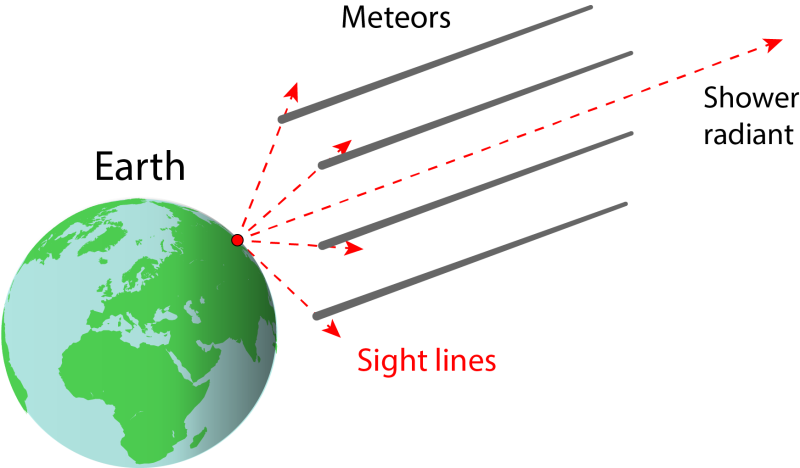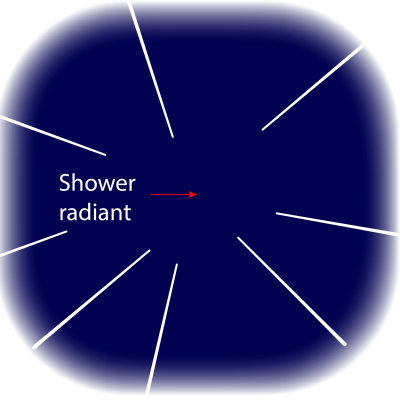3,911 days ago
Dominic Ford, Editor
From
the Meteor Showers
feed
The γ-Normid meteor shower will be active from 25 February to 28 March, producing its peak rate of meteors around 15 March.
Over this period, there will be a chance of seeing γ-Normid meteors whenever the shower's radiant point – in the constellation Norma – is above the horizon, with the number of visible meteors increasing the higher the radiant point is in the sky.
Seen from South El Monte , the shower will not be visible before around 02:44 each night, when its radiant point rises above your eastern horizon. It will then remain active until dawn breaks around 06:36.
The radiant point culminates (is highest in the sky) after dawn – at around 05:00 PDT – and so the shower is likely produce its best displays shortly before dawn, when its radiant point is highest.
At this time, the Earth's rotation turns South El Monte to face optimally towards the direction of the incoming meteors, maximising the number that rain vertically downwards, producing short trails close to the radiant point. At other times, there will be fewer meteors burning up over South El Monte, but those that do will tend to enter the atmosphere at an oblique angle, producing long-lived meteors that may traverse a wide area of the sky before completely burning up.
The shower is expected to reach peak activity at around 20:00 PDT on 14 March 2015.
Observing prospects
At its peak, the shower is expected to produce a nominal rate of around 6 meteors per hour (ZHR). However, this zenithal hourly rate is calculated assuming a perfectly dark sky and that the radiant of the shower is situated directly overhead. In practice, any real observing sight will fall short of these ideal conditions. The number of meteors you are likely to see is thus lower than this, and can be estimated using the ZHR formula.
From South El Monte, the radiant of the shower will appear at a peak altitude of 5° above your horizon, and on the basis of this, we estimate that you are only likely to see only around 0 meteors per hour, even at the shower's peak, since the radiant will be relatively low in the sky.
The shower will peak close to new moon, and so moonlight will present minimal interference.
The origin of the shower
Meteor showers arise when the Earth passes through streams of debris left behind in the wake of comets and asteroids. Over time, the pieces of grit-like debris in these streams distribute themselves along the length of the parent object's orbit around the solar system.
Shooting stars are seen whenever one of these pieces of debris collides with the Earth's atmosphere, typically burning up at an altitude of around 70 to 100 km.
On certain days of the year the Earth's orbit passes through particularly dense streams, associated with comets or asteroids which have vented particularly large amounts of solid material to space, and this gives rise to an annual meteor shower. Such showers recur on an annual basis, whenever the Earth passes the particular point in its orbit where it crosses the particular stream of material.


The meteors that are associated with any particular meteor shower can be distinguished from others because their paths appear to radiate outwards from a common point on the sky, which points back in the direction from which their orbital motion brought them.
This is because the grit particles in any particular stream are travelling in almost exactly the same direction when they cross the Earth's orbit, owing to having very similar orbits to the parent object they came from. They strike the Earth from almost exactly the same direction, and at the same speed.
To see the most meteors, the best place to look is not directly at the radiant itself, but at any dark patch of sky which is around 30–40° away from it. It is at around this distance from the radiant that the most meteors will be seen.
By determining the position of this radiant point on the sky, it is possible to work out the orbit of the stream giving rise to any particular meteor shower. It is sometimes even be possible to identify the particular body responsible for creating the debris stream, if there is a known comet or asteroid with a very similar orbit.
The radiant of the γ-Normid meteor shower is at around right ascension 15h50m, declination 50°S, as shown by the green circle on the planetarium above.
The sky on 28 Nov 2025
| The sky on 28 November 2025 | ||||||||||||||||||||||||||||||||||
|
60% 8 days old |
All times shown in PST.
|
|||||||||||||||||||||||||||||||||
Source
The position of the radiant of this shower, and its predicted hourly rate, were taken from International Meteor Organisation's List of Meteor Showers.
Image credit
© Jacek Halicki 2016. Perseid meteor seen in 2016 from Poland.


